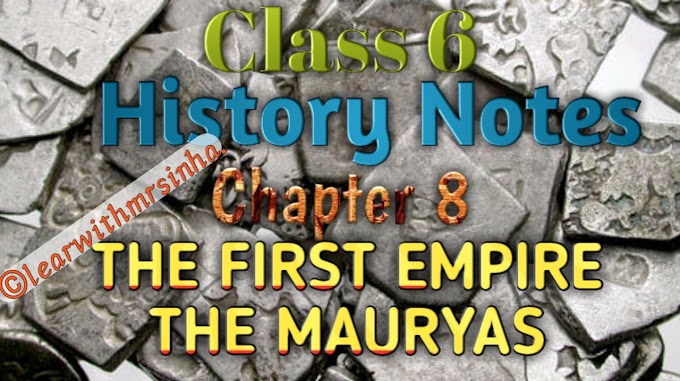History Notes
Class 6
5. THE AGE OF THE VEDAS
Veda means knowlege. Vedas (3000 years ago) one of the earliest literary source.
Age of Vedas :- The period during which vedas were written is called age of vedas.
The Vedas:-
Four Vedas are -
1. Rig Veda 2. Yajur Veda
3. Sama Veda 4. Atharva Veda
They contain hymns in praise of various gods and goddesses.
The period from 1500-1600BC = Vedic Age
The Rig Veda is the oldest Veda. Composed about 3500 years ago.
Divided into 10 mandals or books and 1028 hymns.
Hymns prays of gods :- Indra (the god of rain, war and storm), Agni (fire god), Varun ( sky god) and others.
Painted grey ware and Black-and-red ware pottery found in Hastinapur and Atranjikhera also form place in Ganga valley.
These potteries tell us about the people who composed the vedas. Reffers to an Aryan.
Daily Life:-
Poples were divided into numerous tribes (janas).
Each tribe settle in partcular area consisted of many vilages.
Each tribe has a king not like lateral time .
There were two assemblies
1. Sabha (assembly of elders and important persons )
2. Samiti (assembly of members of every family)
History Notes Class 6
Cattle and Horses were very important.
'Sura' - A type of liquor which was drunk in common festival location.
'Soma' - prepared from milk and juice of rarely grew plants ( mountain) and drank it during special religious ceremonies.
Battles were fought for cattle, land and horse.
Occupation
Agriculture and cattle rearing where the main occupations. Other are - chariot making, pottery making, weaving, jewellery making, metal work, carpentry, tanning and fishing.
Many peoples are priest who conduct religious ceremonies and also act as teachers and doctors.
Ornaments of gold silver and other metal where won by both men and women.
Dasas / Dasus (Slaves)
Another group of peoples whom the Aryan called the dasas or dasyus. (Different culture and language)
Inamagon
Inamagon in Maharashtra, is one of the largest chalcolithic settlement in India. (1000 peoples lived in one time)
The settlement lasted for over 9,000 years. (1500 to 600 BC)
Archeological Finds
As many as 134 mud house have been excavated at Inamagon. (Rectangular with two room)
One house however, has 5 rooms. (Chief) (next to granery)
Found Pottery (read, Black design), Stone tool (Chop), copper ornaments (beads, bangles, anklets), tools (drills, tongue, fish hooks, arrowhead)
Beads of terracota, Shell (seal), Semi-precious stones
Terracota (baked) Figures - Bull, Animals
Peoples worship - bul, female goddess
Crops - Wheat, lentils, beans, peas, gram, beans, meat, fish and dairy products.
Decline - Decline in farming due to lack of rain water / rainfall or decrease in fertility of the soil.
Began relying more on hunting and gathering foods. Houses change to the small huts. (circular)
The Megaliths (Stone Boulders)
Megalith means big stones. In the Deccan, South India, the north east and north west area, (specially Kashmir) huge stone boulders have been found arranged in a circular pattern. (Used to mark grave or burial sites)
Science Notes Class 6
The megaliths have some special features or use.
- Megalithic burials are there underground and megaliths where placed on the surface to mark the burial spot.
- In graves, human skeleton, pottery, agricultural tools, weapons and ornaments can obtained.
Objects in graves shows the richness of people.
*****
#ageofvedas #vedicage #class6notes #class6historynote what books says about us







0 Comments